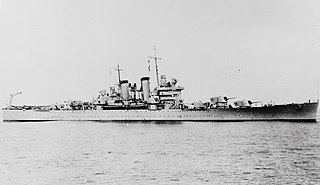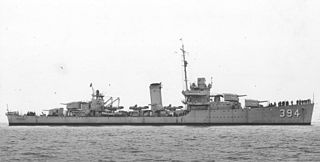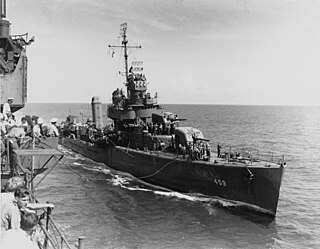
USS Juneau (CL-52) was a United States Navy Atlanta-class light cruiser sunk at the Naval Battle of Guadalcanal 13 November 1942. In total, 687 men, including the five Sullivan brothers, were killed in action as a result of her sinking. She was laid down by Federal Shipbuilding Company, Kearny, New Jersey, on 27 May 1940, launched on 25 October 1941, sponsored by Mrs. Harry I. Lucas, wife of the mayor of the city of Juneau, Alaska, and commissioned on 14 February 1942, with Captain Lyman K. Swenson in command. She was torpedoed and sank on 13 November 1942, with only 10 survivors rescued after 8 days in the water. Subsequent to the loss, the Navy launched USS The Sullivans ships and Juneau-class cruiser, honoring the five Sullivan brothers who died in her sinking and the ship itself, respectively.

USS Atlanta (CL-51) of the United States Navy was the lead ship of the Atlanta class of eight light cruisers. She was the third Navy ship named after the city of Atlanta, Georgia. Designed to provide anti-aircraft protection for US naval task groups, Atlanta served in this capacity in the naval battles Midway and the Eastern Solomons. Atlanta was heavily damaged by Japanese and friendly gunfire in a night surface action on 13 November 1942 during the Naval Battle of Guadalcanal. The cruiser was sunk on her captain's orders in the afternoon of the same day.

The Naval Battle of Guadalcanal, sometimes referred to as the Third and Fourth Battles of Savo Island, the Battle of the Solomons, the Battle of Friday the 13th, or, in Japanese sources, the Third Battle of the Solomon Sea, took place from 12–15 November 1942, and was the decisive engagement in a series of naval battles between Allied and Imperial Japanese forces during the months-long Guadalcanal Campaign in the Solomon Islands during World War II. The action consisted of combined air and sea engagements over four days, most near Guadalcanal and all related to a Japanese effort to reinforce land forces on the island. The only two U.S. Navy admirals to be killed in a surface engagement in the war were lost in this battle.

USS Helena (CL-50) was a Brooklyn-class light cruiser built for the United States Navy in the late 1930s, the ninth and final member of the class. The Brooklyns were the first modern light cruisers built by the US Navy under the limitations of the London Naval Treaty, and they were intended to counter the Japanese Mogami class; as such, they carried a battery of fifteen 6-inch (150 mm) guns, the same gun armament carried by the Mogamis. Helena and her sister St. Louis were built to a slightly modified design with a unit system of machinery and an improved anti-aircraft battery. Completed in late 1939, Helena spent the first two years of her career in peacetime training that accelerated as tensions between the United States and Japan increased through 1941. She was torpedoed at the attack on Pearl Harbor in December 1941 and was repaired and modernized in early 1942.

USS San Francisco (CA-38), a New Orleans-class cruiser, was the second ship of three of the United States Navy named after the city of San Francisco, California. Commissioned in 1934, she was one of the most decorated ships of World War II, earning 17 battle stars and the Presidential Unit Citation.

USS Aaron Ward (DD-483) was a Gleaves-class destroyer in the service of the United States Navy. She was the second Navy ship named in honor of Rear Admiral Aaron Ward. She sank on 7 April 1943 in a shoal near Tinete Point of Nggela Sule, Solomon Islands during Operation I-Go. Her wreck was discovered on 4 September 1994.

USS Gwin (DD-433), a Gleaves-class destroyer, was the third ship of the United States Navy to be named for Lieutenant Commander William Gwin, an American Civil War officer who commanded river boats against Confederate forces in Alabama.

USS Monssen (DD-436), a Gleaves-class destroyer, was the first ship of the United States Navy to be named for Mons Monssen, who was awarded the Medal of Honor for his actions aboard USS Missouri (BB-11) in 1904. Commissioned in 1941, the destroyer saw service during World War II in both Atlantic and Pacific Oceans. Monssen was sunk at the Naval Battle of Guadalcanal on 13 November 1942.

USS McCalla (DD-488), a Gleaves-class destroyer, was the second ship of the United States Navy to be named for Bowman H. McCalla, who served during the Spanish–American War and would eventually attain the rank of rear admiral.

USS Trever (DD-339/DMS-16/AG-110) was a Clemson-class destroyer of the United States Navy in commission from 1922 to 1923 and from 1930 to 1945. Converted to a destroyer minesweeper in 1940, she served in the Pacific throughout World War II, including during the Japanese attack on Pearl Harbor, the Guadalcanal campaign, and the New Georgia campaign.

USS Patterson (DD-392), a Bagley-class destroyer, was the second ship of the United States Navy to be named for Daniel Todd Patterson, an officer of the US Navy who served in the Quasi-War with France, First Barbary War, and the War of 1812.

USS Lardner (DD-487), a Gleaves-class destroyer, was the second United States Navy ship to be named for Rear Admiral James L. Lardner, a Naval officer during the American Civil War. Lardner received 10 battle stars for World War II service.

The second USS Sampson (DD-394) was a Somers-class destroyer in the United States Navy. She was named of William Thomas Sampson a rear admiral known for his victory in the Battle of Santiago de Cuba during the Spanish–American War.

USS Sterett (DD-407) was a Benham-class destroyer in the United States Navy. She was the second Navy ship named for Andrew Sterett.

USS Laffey (DD-459) was a Benson-class destroyer of the United States Navy during World War II. She was the first destroyer named for Bartlett Laffey.

USS Woodworth (DD-460) was a Benson-class destroyer in the United States Navy during World War II. She was named for Commander Selim E. Woodworth.

USS Farenholt (DD-491) was a Benson-class destroyer in the United States Navy during World War II. She was the second ship named for Admiral Oscar Farenholt.

USS John Penn (APA-23) was an attack transport that served with the US Navy during World War II. Named after John Penn, a signatory to the American Declaration of Independence, she was the only ship in her class.

USS Zeilin (APA-3) was an Emergency Fleet Corporation Design 1029 ship launched for the United States Shipping Board (USSB) on 19 March 1921 by Newport News Shipbuilding and Drydock Company in Newport News, Virginia as Silver State. After operation by commercial lines for the USSB, during which the ship was renamed President Jackson, the ship was purchased and operated commercially until laid up in the late 1930s.

On 7 August 1942, US and Australian naval forces undertook the invasion of the Japanese-held islands of Guadalcanal and Tulagi in the lower Solomon Islands chain, the first Allied offensive in the Pacific Theatre. The landing of the US 1st Marine Division on the beaches of Savo Sound began the unexpectedly long and extremely arduous Guadalcanal Campaign, lasting officially until 9 February 1943.




















